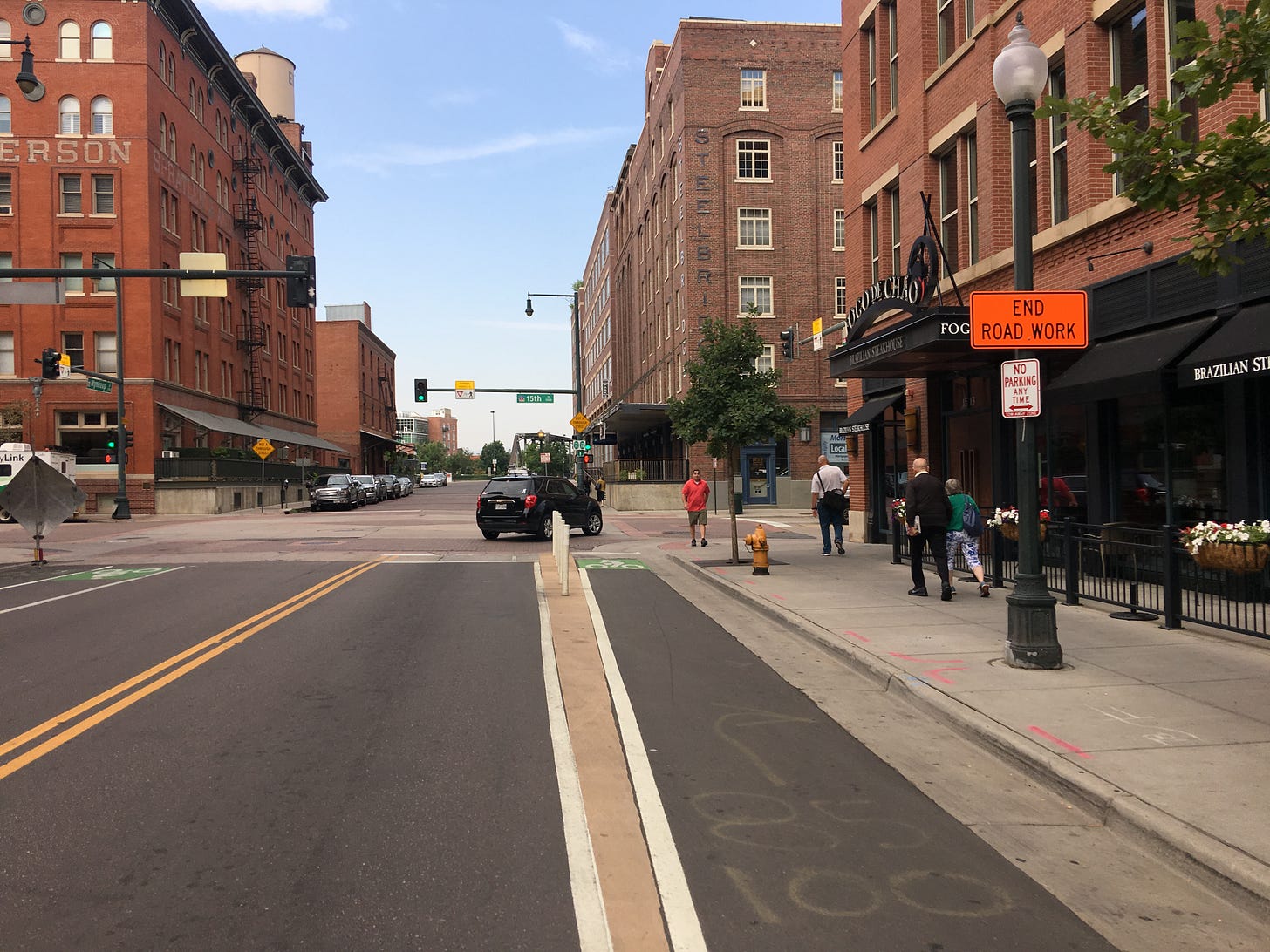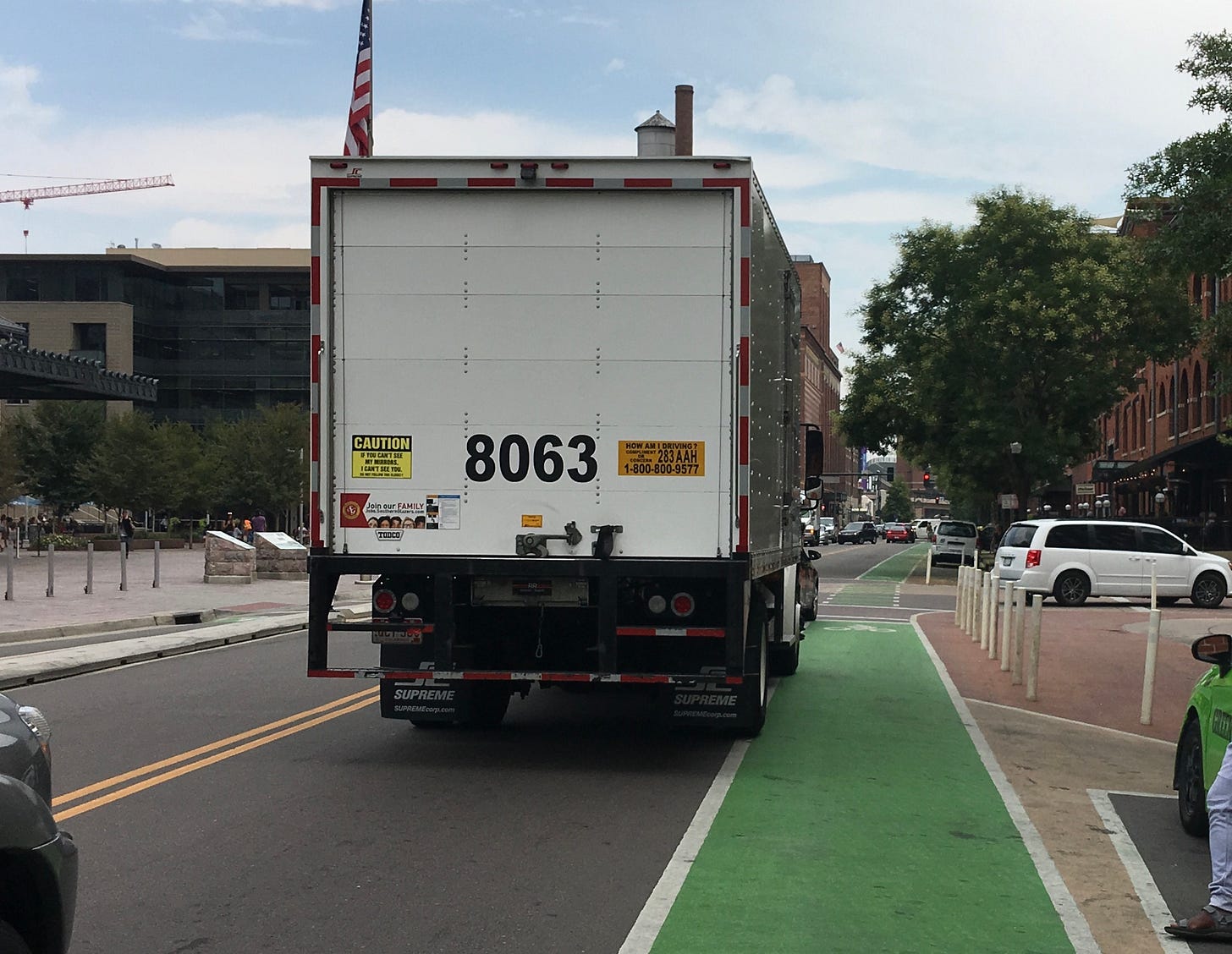"A Mortal Danger to Cyclists"
Mike Rosen's take on Denver's "protected" bicycle lanes
Mike Rosen, a former talk show host for the AM radio station KOA, former newspaper columnist for the Rocky Mountain News and Denver Post Pest now writes for the website Compete Colorado. His latest column, Denver Government’s Self-Sabotaging Priorities highlights the failures of the progressive leaning leadership under the regime of Mike Johnson in the Mile High City from issues to homelessness to the downtown’s lagging economic recovery.
Rosen takes a shot too at the progressive pet project of climate change activism and the associated “solutions” including Denver’s installation of bicycle lanes which stems from an anti-motoring (and anti-working class!) agenda.
Denver city council members afflicted with climate change paranoia and hell bent on “urban density” have bragged about making driving an aggravating ordeal for motorists. They succeeded. Big mistake. Those stupid bike lanes that steal auto lanes 1—especially on Broadway and 15th Street — clog traffic, are a mortal danger to cyclists, are under-utilized, and will never be a significant mode of public transportation. Let’s get rid of them. Also, return speed limits to what they used to be. Twenty mph on city streets and 30 mph on four-lane divided roads are too slow.
That aside it’s hard to tell where Rosen got the idea of the “mortal danger to cyclists” of these bicycle lanes and that might be a bit of hysteria but he’s pointing towards the right direction - especially in Denver which has seen a surge in the construction of not just bicycle lanes but ones of the “protected” variety.
Or perhaps he sees what legitimate, principled-driven bicyclist have been seeing?
It’s hard to tell in Rosen’s point of view, when or if, any cycling lane in the city would not be “under-utilized” and it doesn’t help that proponents of these cycling lanes don’t have good before and after data to support their various claims. It’s also unknown if Rosen is aware of the entire “traffic violence epidemic” narrative these people insist but if he is, I hope he can can at least laugh at the absurdity of it.
These “protected” lanes incorporate some sort of vertical barrier or similar object to separate the bicycle lane from the general-use travel lanes. “Protected” bicycle lanes are viewed by their supporters as an “upgrade” to both riding with other traffic in accordance to the rules of the road for drivers of vehicles or standard painted bicycle lanes. Inspired by the bicycling “utopia” of select Western European cities such as Amsterdam or Copenhagen of which supporters of these expensive projects want to emulate, the idea is that people won’t drop their cars and adopt a bicycle is because they don’t “feel safe.” The current “car brain” centric system isn’t “safe for all ages and abilities,” they insist.
It should be noted for those in Colorado that this ideology is backed by people such as Wesley Marshall, an academic/activist “civil engineer” with CU Denver whose salary is paid for by Colorado taxpayers and whose research is funded by both US taxpayers and the fiat money printer. Marshall is the co-author of an immensely flawed (yet often citied by protected bicycle lane activists) study that “protected” bicycle lanes make the roadway network not just safer for bicyclists but also for other users such as motorists and pedestrians.
“Safe for all road users”
“This paper provides an evidence-based approach to building safer cities,” begins the conclusion of the study, “Why cities with high bicycling rates are safer for all road users” a study conducted by academics Wesley Marshall and Nicolas Feranchak. Published in 2019 in the
But the most common types of crashes between bicyclists and motorists come from when one party turns or crosses over the path of the other - something Marshall’s study neglected to study.
In the case of bicyclists, who are usually operating on the edge of the road, that means the motorist may turn left or right in front of them (colloquially called a “left cross” or a “right hook”), may not see them upon pulling out of a street parking spot or driveway (“drive out”) or may fail to properly see them on front (surprisingly rare though much feared) or fail to properly overtake (rare but more common in rural situations). Those first three crash types are even more likely to occur if the cyclist is riding on the sidewalk, and/or riding the wrong direction facing traffic (“salmoning”) , riding at night without lights, or riding intoxicated. None of these issues are fixed by installing “protected” bicycle lanes.
Now back to Denver.
Denver is full of bike lanes, a few good, most bad but in general has seen an increase in the installation of these “protected” bicycle lanes before the Johnson colonization. But Johnson’s regime has paved the way for more radical activists such as those in what they call the Denver Bicycle Lobby.
The Longhouse Bicycle Lobby House Rules
Presented with no other commentary, this is from one of the organizations in Denver, Colorado lobbying for the dangerous bicycle lanes, often labeled as “protected” that are slowly popping up around the city.
Rosen focuses on two bike lane projects in Denver, the one that runs along Broadway and another that runs along 15th.
Broadway’s is a two-way cycletrap with dedicated traffic signals for bicyclists which theoretically separate their movements from that of motorists. Yet anecdotally, few bicyclists, “scooterists” or other non-car users of the bikeway obey them - ironically increasing their risk for the most common and most injury or fatal prone crashes. This is an inconvenient truth to those in the bike lane ideology who insist bicyclists are not only better than motorists but also seen as noble victims regardless of the situation. The bikeways, presumably not swept or swept enough contains crash-causing debris too. I also don’t visit Denver often but summer of 2023 did note that homeless encampments were present in the “protected” bikeway.
The other bikeway project Rosen mentions is 15th which at least per Google Streetview saw only a reduction in street parking, not actual moving travel lane capacity. Needless to say, the “protected” bicycle lane that runs along this street now creates issues for motorists and bicyclists. An issue for this particular bicyclist was the transition between at-grade segregation and above grade segregation which seemingly changes with no warning and for no reason making it a crash hazard to enter and exit the bikeway to avoid hazards, pass other people, or to prepare for a right turn. The “flex posts”, “designed” to protect bicyclists from motor vehicles are also a crash hazard to the cyclists themselves. All of these support Rosen’s claim of the bikeway’s “mortal danger to bicyclists.”
Denver also has its fair share of garbage “unprotected” lanes too making one wonder how anybody with even one close call cycling is going to want to continue.
Below is a mix of both and represent the worst of what Denver has to offer.




At least in Denver’s downtown area, anecdotally, few bicyclists obey traffic rules and it’s excuse my language, a clusterfuck of incompetent “mobility device users” and cyclists trying to share the same spaces. Riding out in the road ensures with the “big evil cars” ensures far less stress and conflicts to normal people not parasitized by bike lane victimology. To add to the chaos is that stopping at red lights and stop signs is now legal in many cases but both the “science” around the reasoning for this isn’t solid and so far nobody has tried to come up with any data to support whether this made Colorado cyclists safer since it became state law in July 2023. In general as a trained, normal principled bicyclist who doesn’t want “war” with other road users, I can’t think of a better way to alienate others than with that Denver is doing to all road users in their “protected” bicycle regime or draw ire from non-bicyclists.
To be pedantic, yet legally accurate, there is no such thing as an “auto lane,” with the exception of maybe most of the state’s urban freeways, which do legally prohibit bicycles and other slow-moving vehicles. “Bicycle-friendly” Fort Collins Colorado also has a ban, imposed by an obscure law that prohibits bicyclists on portions of US 287 (the city’s “main drag”) through the city which the cowards at the League of American Bicyclists nor local advocacy groups have even tried to fight. But other than that, there are no such thing as “auto lanes” - every single mile of surface street is open to bicyclists which in Colorado are considered vehicles (not to be confused with motor vehicles) and their operators while on the public highway system are considered drivers.





Your post has certainly sparked a lot of interest. Looking at the links and yours has a lot! Thanks for sending!
C
Palm Springs Ca. has done a fine job of integrating bike lanes with sidewalks and traffic. They use more traditional (unprotected) bike lanes on many streets. They've done it without lowering speed limits and avoiding, for the most part, causing a nuisance for drivers. There will always be conflicts between bikes and automobiles but a few cities are figuring out good compromises .